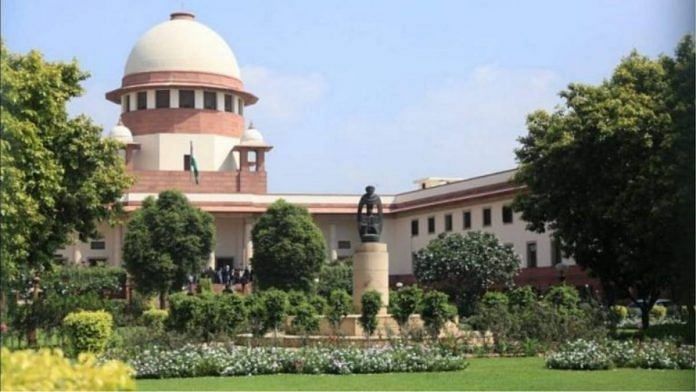New Delhi: Asserting its right to fix the criteria for the Economically Weaker Section (EWS) of the society, the Central government has defended the criteria adopted by it to determine the EWS and is likely to urge the Supreme Court that the system should be allowed to continue and is not modified or changed, ThePrint has learnt.
“The present system/criteria adopted by the government for determination of EWS in 2019, has been working satisfactorily ever since without much complaints or litigations. Therefore, it is in public interest that the system be allowed to continue and is not further modified/changed,” said a senior government official.
The Supreme Court had on 8 October questioned the methodology adopted by the Central government in fixing Rs 8 lakh as the annual income limit to identify the EWS for providing 10 per cent quota in jobs and educational institutions. The SC had been hearing petitions challenging the quota for EWS in medical admissions.
On 29 July, the government had issued a notification introducing 10 per cent EWS quota, apart from 27 per cent quota for other backward classes (OBC) within the All-India Quota (AIQ) seats for postgraduate medical courses from this academic year.
Following this, 2,500 PG seats in government medical colleges would go to OBCs and 1,000 to EWS. However, this was challenged in a number of petitions.
In its affidavit likely to be submitted Wednesday, the Central government is expected to provide details on why Rs 8 lakh was fixed as the income criteria for OBC and EWS.
“The income limit for EWS largely followed the income limits fixed for the creamy layer fixed for the OBCs. Prior to 2017, the upper-income layer limit for determination of creamy layer in respect of OBCs was Rs 6 lakh/pa (as per orders issued in 2014). In order to maintain the same living standard in 2017, the income limit was adjusted based on the Consumer Price Index (CPI),” explained a senior government official.
“The CPI increased to 268 (Index March 2016) from 197 (Index December 2011), resulting in a multiple of 1.36. Multiplying the existing income limit of Rs 6 lakh with this factor, the income level for maintaining the same living standard would be Rs 8.16 lakh per annum. After rounding off the figure, the Government arrived at the limit of Rs 8 lakh, which has been adopted as the creamy layer annual income limit.”
Also read: Reactions to OBC medical quota are exposing Indians’ flawed merit argument all over again
‘Income limits applied equally across countries’
In its affidavit, the government is likely to state that income limits are always applied equally across the country. “Otherwise, there will be confusion and chaos in applying this limit for reservations,” the official said.
“India is a vast country with varied geographical locations, culture, languages, and climate. These conditions vary to a great extent within a state also. The development of any area is also directly related to economic activities, and it is possible that a backward region today may develop rapidly into an industrial/economic active zone in a very short time. Therefore, it would not be possible for the government to keep separate guidelines for different states/regions/sub-regions/towns/villages of the country for determination of the Economic Backwardness amongst EWS.”
The government in its affidavit is also likely to state that the EWS reservations are based on the amended Article 15 and 16 of the Constitution to recognise the economic backwardness for providing reservation in education and employment opportunities.
“The Central Government is authorised to prescribe the criteria for identifying the EWS persons. As can be seen, while prescribing the eligibility criteria, due care has been taken to exclude those who are well-off and include only those who fall within an income limit. This limit itself has been drawn based on the detailed exercise in a similar case of defining creamy layer for OBCs,” the official said.
(Edited by Poulomi Banerjee)
Also read: EWS quota is a bad law, it needs to go



